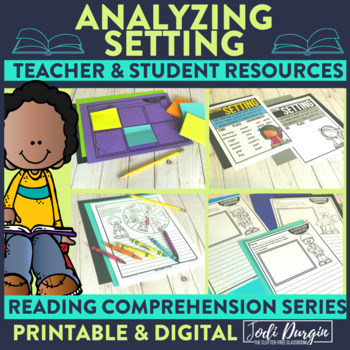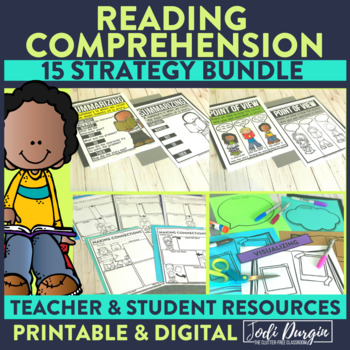Analyzing setting is an important reading comprehension strategy for elementary students to become proficient in. Setting is an important element of a story because it has an effect on the plot, characters, and overall tone. The setting also impacts how characters act, talk, and travel. Being able to identify the setting helps readers better understand and enjoy stories they read and listen to. Learn all about how to teach setting below!
What is the Setting of a Story?
Every story has a setting, which is the time and place the story occurs. Commonly, the setting is thought of as where a story takes place. However, it is important to teach students that the setting is also time: consider if the story takes place in the past, present, or future, time of year, and time of day. Authors do not always directly tell readers what the setting of a story is. Readers must use their inferencing skills to analyze clues and determine the setting.
Setting is an important element of a story because it has an effect on the plot, characters, and overall tone. The setting also impacts how characters act, talk, and travel. Some stories have a single setting, while others have multiple settings. It can change throughout a story and therefore characters must adjust to these changes.
Why Is Analyzing Setting an Important Comprehension Strategy?
The ability to identify story elements, such as setting, is important for readers. When students are able to identify and analyze the setting, they have a deeper understanding of the story. When students are asked to find the setting of a story, they have a purpose for their reading which helps them to recall details.
Understanding the setting is important for students because setting influences the plot and characters. If students have a deep understanding of the setting, they will better understand why specific events happen, why characters act the way they do, and how characters are feeling in the story. Readers must be able to understand a setting in order to understand the characters, because setting impacts how they live.
Teaching Standards for Setting
Standards for this reading comprehension topic include…
CCSS
- RL.1.3: Describe characters, settings, and major events in a story, using key details.
- RL.2.3: Describe how characters in a story respond to major events and challenges.
- RL.3.3: Describe characters in a story (e.g., their traits, motivations, or feelings) and explain how their actions contribute to the sequence of events.
- RL.4.3: Describe in depth a character, setting, or event in a story or drama, drawing on specific details in the text (e.g., a character’s thoughts, words, or actions).
- RL.5.3: Compare and contrast two or more characters, settings, or events in a story or drama, drawing on specific details in the text (e.g., how characters interact).
TEKS
- LA.1.8.B: describe the main character(s) and the reason(s) for their actions;
- LA.1.8.C: describe plot elements, including the main events, the problem, and the resolution, for texts read aloud and independently; and
- LA.1.8.D: describe the setting.
- LA.2.8.B: describe the main character’s (characters’) internal and external traits;
- LA.2.8.C: describe and understand plot elements, including the main events, the conflict, and the resolution, for texts read aloud and independently; and
- LA.2.8.D: describe the importance of the setting.
- LA.3.8.B: explain the relationships among the major and minor characters;
- LA.3.8.C: analyze plot elements, including the sequence of events, the conflict, and the resolution; and
- LA.3.8.D: explain the influence of the setting on the plot.
- LA.4.8.B: explain the interactions of the characters and the changes they undergo;
- LA.4.8.C: analyze plot elements, including the rising action, climax, falling action, and resolution; and
- LA.4.8.D: explain the influence of the setting, including historical and cultural settings, on the plot.
- LA.5.8.B: analyze the relationships of and conflicts among the characters;
- LA.5.8.C: analyze plot elements, including rising action, climax, falling action, and resolution; and
- LA.5.8.D: analyze the influence of the setting, including historical and cultural settings, on the plot.
3 Tips for Teaching Students to Analyze Setting
Below are suggestions for when you teach your students to analyze the setting when reading.
1. Read Aloud Picture Books
Reading aloud picture books is a great way to model and practice this reading comprehension strategy. There are tons of great read alouds out there for teaching students to analyze the setting of a book. Some high-quality examples include The Curious Garden, Make Way for Ducklings, One Green Apple, Roxaboxen, and Fletcher and the Falling Leaves.
2. Make Anchor Charts
Anchor charts are another great way to teach students about analyzing the setting in children’s books. My analyzing setting resource includes an interactive anchor chart that successfully engages students in their learning and provides a visual learning experience for students to learn about analyzing the setting.
3. Use Videos
The third on the list of tips for teaching students to analyze the setting is playing videos. This is another great visual learning opportunity for students to learn about what can feel like a very abstract idea. Below are some examples of videos that are great for teaching students how to analyze the setting in picture books.
- https://jr.brainpop.com/readingandwriting/storyelements/setting/
- https://www.youtube.com/watch?v=N5USpsvsNJw
Resources for Teaching Setting
These printable and digital resources for teaching elementary students about setting of a story make curriculum and lesson planning quick and easy. It includes teacher, parent, and student resources, so you’ll have everything you need to deliver meaningful research-based instruction rooted in current best practices.
What is Included
1. Teacher Resources
There are teacher notes about the strategy, teaching ideas, a planning page with question prompts, and list of mentor texts, so you have all of the information you need to plan a research and standards-based reading unit based on this reading comprehension strategy.
2. Parent Resources
There is a parent letter and a reading log with suggested question prompts so parents can confidently support and reinforce the strategy you are teaching with their children at home.
3. Instructional Resources
There are printables to create a large anchor chart and reference charts. Both save you lots of time searching for anchor chart ideas and supplemental teaching tools.
4. Student Resources
There are 3 printables and 2 activities for students that provide meaningful opportunities to practice and make sense of the reading strategy in a fun and engaging way.
5. Digital Resources
There are digital versions of several of the resources so students can access them in school or at home using a technology device of their choice.
Why Teachers Love this Resource
- This collection of resources is versatile in that it can be used on it’s own or can be used to supplement any reading curriculum, so you will be able to continue to use these resources if your school adopts a new reading program or you switch school districts.
- This resource is part of a larger collection of reading strategy products, so you can provide a consistent instructional approach that your students quickly learn and understand the expectations and routines for. Learn more about this collection here!
- It’s a huge time saver! Instead of hunting for background information on a reading strategy and then searching for resources to teach the strategy, this comprehensive resource includes all of the information and resources you need to teach a whole unit on this reading strategy.
- The student activities are a lot of fun for students, which helps create a productive learning environment where students are engaged and learning!
- It includes resources that provide a great way to create a home-school connection with students’ families and support parents/guardians in continuing student learning at home.
In closing, we hope you found this post about how to teach setting of a story helpful! If you did, then you may also be interested in this other post about elementary reading comprehension strategies.




